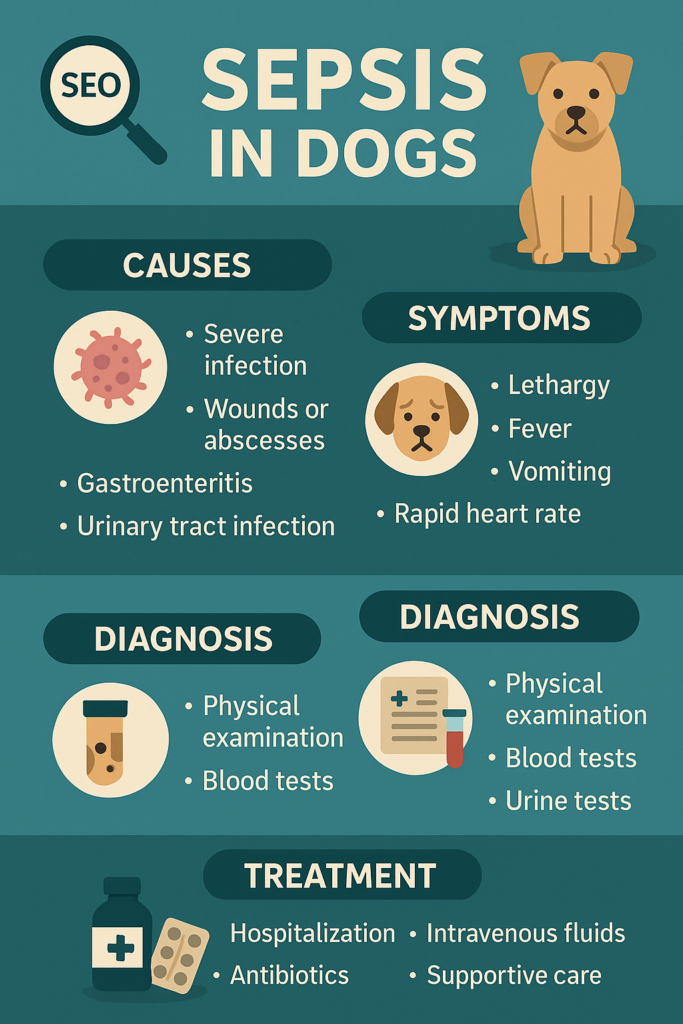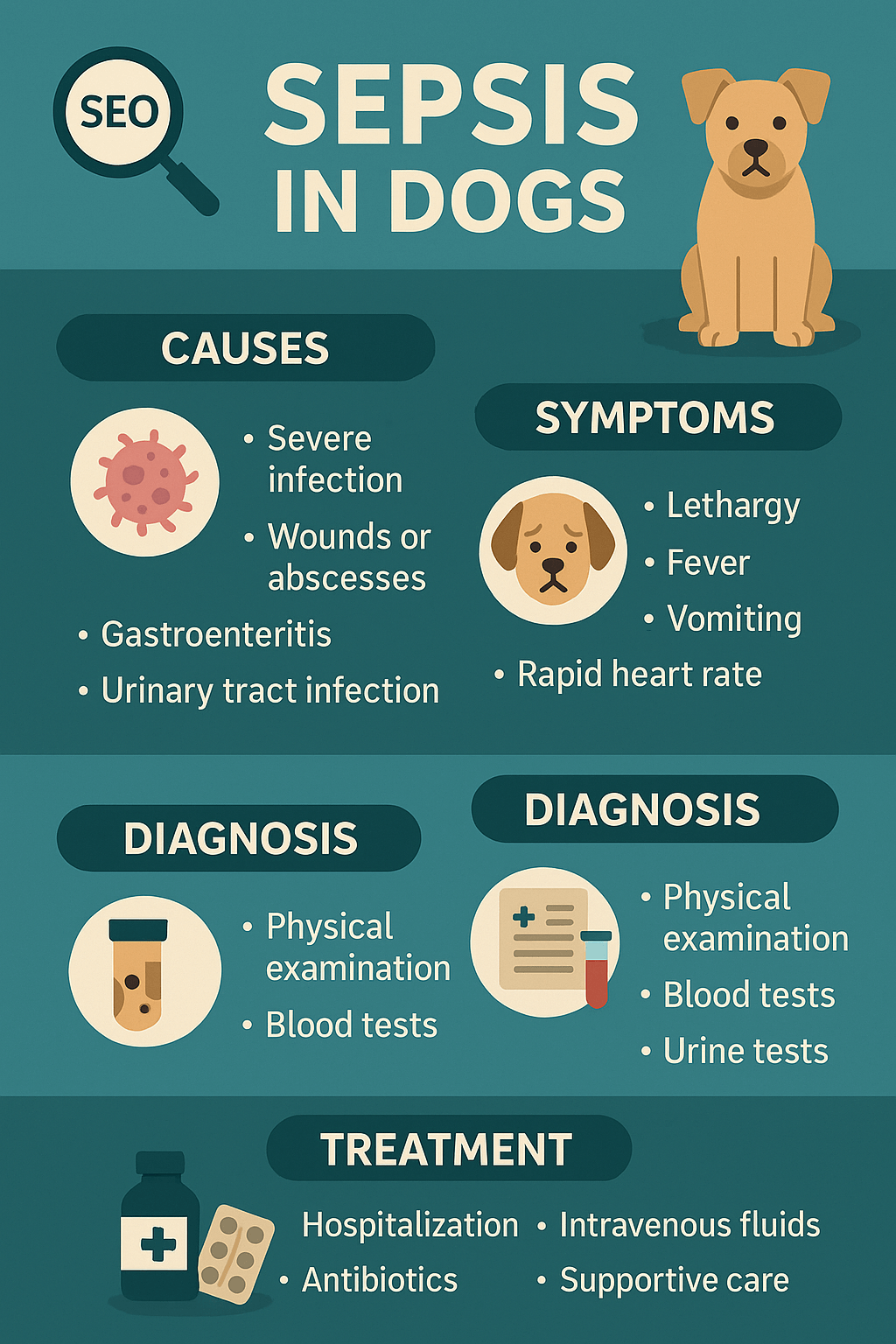Sepsis in Dogs: Understanding a Serious Health Threat
Sepsis is a life-threatening condition that can affect dogs just as it does humans. It occurs when the body’s response to an infection spirals out of control, leading to widespread inflammation and organ dysfunction. While sepsis is rare, it demands immediate attention due to its rapid progression and potentially fatal outcomes. Early recognition of symptoms, prompt veterinary care, and proper management are critical to improving a dog’s chances of survival. In this blog post, we’ll explore what sepsis is, how it develops, and what you can do to protect your furry friend from this dangerous condition.
Expert Insight on Sepsis in Dogs
“Sepsis is the body’s extreme reaction to an infection. Sepsis is a twofold condition—first, the infection, and then the body’s systemic (whole-body) response to the infection. The infection triggers a chain reaction throughout the body, leading to sepsis. The most common cause is bacterial infection. However, sepsis can also be caused by viruses, parasites, or fungal infections.”
What Causes Sepsis in Dogs?
Sepsis typically begins with an infection that overwhelms the immune system, triggering a cascade of harmful responses throughout the body. Understanding the common causes can help prevent this serious condition.
Bacterial Infections:
The most frequent cause of sepsis in dogs is bacterial infections, which can originate from wounds, urinary tract infections, or dental abscesses.Internal Infections:
Conditions like pneumonia, pyometra (infection of the uterus), or gastrointestinal infections can lead to sepsis if left untreated.Tick-Borne Diseases:
Infections such as Lyme disease or ehrlichiosis, transmitted by ticks, can sometimes progress to sepsis in vulnerable dogs.Surgical Complications:
Post-surgical infections, though rare, can develop into sepsis if bacteria enter the bloodstream during or after a procedure.Weakened Immune Systems:
Older dogs, puppies, or those with compromised immune systems are at higher risk of developing sepsis from even minor infections.
By addressing infections early and maintaining your dog’s overall health, you can significantly reduce the risk of sepsis.

Signs and Symptoms of Sepsis in Dogs
Recognizing the signs of sepsis early can make all the difference in saving your dog’s life. These symptoms often appear suddenly and worsen rapidly, so vigilance is key.
Fever or Hypothermia:
A high fever or unusually low body temperature can indicate an overwhelming infection.Lethargy and Weakness:
Dogs with sepsis often seem unusually tired, unresponsive, or reluctant to move.Rapid Breathing or Difficulty Breathing:
Labored breathing or panting without exertion may signal respiratory distress caused by sepsis.Loss of Appetite:
A sudden refusal to eat or drink is a common symptom of systemic illness in dogs.Vomiting or Diarrhea:
Gastrointestinal upset, including vomiting or bloody diarrhea, can occur as the body struggles to fight the infection.
If your dog exhibits any of these symptoms, seek veterinary care immediately to rule out or address sepsis.
Check this guide 👉Encephalitis in Dogs: Best 7 Expert Tips!
Check this guide 👉Understanding Keratitis in Dogs: Best 7 Expert Tips!
Check this guide 👉Hyperthyroidism in Dogs: Best 7 Expert Tips!
Risk Factors for Sepsis | Preventive Measures |
|---|---|
Open wounds or injuries | Clean and disinfect wounds promptly |
Untreated infections | Address infections early with vet care |
Age (puppies or senior dogs) | Regular check-ups for vulnerable dogs |
Tick exposure | Use tick prevention products year-round |
Recent surgeries | Monitor incision sites for signs of infection |
How Is Sepsis Diagnosed and Treated?
Diagnosing and treating sepsis requires professional veterinary intervention. Early diagnosis and aggressive treatment are crucial for improving survival rates.
Physical Examination:
Vets will assess your dog’s overall condition, checking for signs of infection or organ failure.Blood Tests:
Blood work can reveal elevated white blood cell counts, abnormal organ function, or the presence of bacteria in the bloodstream.Imaging Tests:
X-rays or ultrasounds may be used to identify underlying infections or complications.Antibiotics and Fluid Therapy:
Aggressive antibiotic treatment and intravenous fluids are standard protocols to combat infection and stabilize the dog.Supportive Care:
Oxygen therapy, pain management, and nutritional support may be necessary to aid recovery.
With timely intervention, many dogs can recover from sepsis, though long-term care may be required.
Tips for Preventing Sepsis in Dogs
Preventing sepsis starts with proactive care and attentiveness to your dog’s health. These tips can help minimize risks and keep your pet safe.
Regular Vet Check-Ups:
Routine exams allow vets to catch and treat infections before they escalate.Prompt Wound Care:
Clean any cuts or scrapes thoroughly and monitor for signs of infection.Maintain Dental Hygiene:
Regular brushing and dental cleanings prevent oral infections that could lead to sepsis.Tick Prevention:
Use vet-recommended tick preventatives to reduce the risk of tick-borne diseases.Monitor for Changes in Behavior:
Pay attention to sudden shifts in energy, appetite, or behavior, as these can signal underlying issues.
By taking preventive measures, you can safeguard your dog against the dangers of sepsis.
Common Misconceptions About Sepsis in Dogs
Many dog owners misunderstand sepsis, which can delay treatment or lead to unnecessary worry. Clearing up these misconceptions helps ensure better care for your pet.
Sepsis Only Happens in Sick Dogs:
Even healthy dogs can develop sepsis if an infection goes untreated.All Infections Lead to Sepsis:
While not every infection progresses to sepsis, ignoring signs increases the risk.Sepsis Is Always Fatal:
With early intervention, many dogs survive sepsis and regain their quality of life.Antibiotics Alone Are Enough:
Sepsis requires comprehensive treatment, including fluids, monitoring, and supportive care.Older Dogs Can’t Recover from Sepsis:
Age is a factor, but senior dogs can recover with proper care and attention.
Understanding these truths empowers you to act decisively if your dog shows signs of sepsis.
Long-Term Effects of Sepsis on Dogs
Even after recovering from sepsis, some dogs may experience lingering effects that require ongoing care. Being aware of these possibilities helps you prepare for your dog’s future needs.
Organ Damage:
Sepsis can cause permanent damage to organs like the kidneys or liver, requiring lifelong monitoring.Weakened Immune System:
Survivors may have reduced immunity, making them more susceptible to future infections.Behavioral Changes:
Some dogs exhibit anxiety or lethargy as a result of their traumatic experience.Chronic Pain or Mobility Issues:
Joint or muscle problems may arise from prolonged immobility during recovery.Increased Veterinary Needs:
Regular follow-ups and specialized care may be necessary to manage post-sepsis complications.
Addressing these effects ensures your dog enjoys a comfortable and fulfilling life after recovery.
Supporting Your Dog During Recovery from Sepsis
Recovery from sepsis is a gradual process that requires patience and dedication. Providing the right support accelerates healing and improves your dog’s quality of life.
Follow Vet Instructions Carefully:
Adhere to medication schedules and dietary recommendations provided by your vet.Create a Stress-Free Environment:
Keep your dog calm and comfortable to promote rest and healing.Encourage Gentle Exercise:
Short walks or light playtime can help rebuild strength without overexertion.Monitor for Recurrence of Symptoms:
Watch for signs of infection or other health issues and report them to your vet immediately.Offer Emotional Support:
Spend quality time with your dog to reassure them and strengthen your bond during recovery.
With love and care, your dog can overcome the challenges of sepsis and thrive once again.
Frequently Asked Questions About Sepsis in Dogs
Can sepsis be cured in dogs?
With early and aggressive treatment, many dogs can recover from sepsis, but success depends on the severity and underlying cause.
How quickly does sepsis progress?
Sepsis can worsen within hours, making immediate veterinary attention critical.
Is sepsis painful for dogs?
Yes, sepsis can cause significant discomfort, which is why pain management is part of the treatment plan.
Are certain breeds more prone to sepsis?
While no specific breed is predisposed, dogs with weaker immune systems or chronic conditions face higher risks.
What should I do if I suspect sepsis?
Contact your veterinarian immediately and describe your dog’s symptoms in detail.
Protecting Your Dog from Sepsis
Sepsis is a serious and potentially life-threatening condition, but with awareness and proactive care, you can significantly reduce the risks. By understanding the causes, recognizing the symptoms, and seeking prompt veterinary attention, you give your dog the best chance at recovery. Prevention is always better than cure, so prioritize regular check-ups, maintain good hygiene, and stay vigilant for any changes in your dog’s health. Remember, your furry companion relies on you to keep them safe—knowledge and action are their strongest allies.
Canned Pumpkin for Cat Diarrhea: Best 7 Expert Tips! Natural remedy to firm stools, soothe upset bellies, and support gut health safely.
Can a Cat Give You Scabies? Best 7 Expert Tips! Discover the truth about feline mites, human skin risks, and how to protect yourself—without panic.
Cat Flea vs Human Flea: Best 7 Expert Tips! Discover the truth about bites, species, and how to eliminate infestations for good.
Weird Cat Behaviors: Best 7 Expert Tips! Discover why cats do strange things—and how to understand, not punish, their instincts for a happier home.





